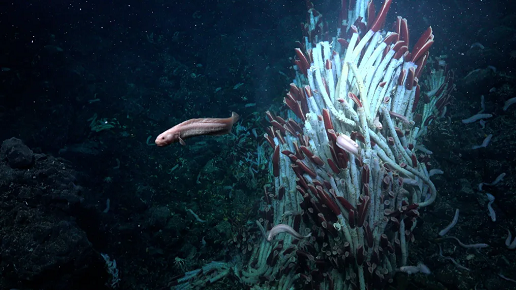Scientists have discovered hidden animal communities, such as tube worms and snails, living in volcanic caves under the seafloor near hydrothermal vents off Central America. This surprising find was made during a 30-day expedition on the research vessel "Falkor (too)" using the SuBastian remotely operated vehicle (ROV) equipped with sensors to explore volcanic areas at the East Pacific Rise. The vents, which expel hot, mineral-rich fluid, foster unique ecosystems where bacteria, mussels, tube worms, and other animals live, often thriving in extreme conditions.
The research uncovered caves filled with giant tube worms, some up to 1.6 feet long, and other organisms, revealing that the ecosystem above and below the seafloor is interconnected. Tube worm larvae and other animals likely travel through cracks filled with warm fluid to settle beneath and around these vents. This discovery suggests that hydrothermal vent ecosystems are larger and more complex than previously understood, with potentially vast, interconnected subhabitats.
The study’s lead author, Dr. Monika Bright, and coauthor Dr. Sabine Gollner employed innovative methods, including drilling and flipping small volcanic rocks, to access these underground spaces. The team was careful to minimize disturbance, lifting only small seafloor sections to prevent disrupting the vent ecosystem. They cautioned that deep-sea mining could harm these ecosystems by redirecting vent fluids, which the life forms depend on for survival. A large cluster of stationary tube worms thrives at the Fava Flow Suburbs, a site on the East Pacific Rise. ROV SuBastian/Schmidt Ocean Institute
A large cluster of stationary tube worms thrives at the Fava Flow Suburbs, a site on the East Pacific Rise. ROV SuBastian/Schmidt Ocean Institute
“This discovery opens a new chapter in our understanding of vent ecosystems, highlighting the importance of protecting life not only on the ocean floor but also in the unexplored layers beneath,” said Dr. Bright. Researchers now aim to determine if similar communities exist under all hydrothermal vents and to study the extent of these hidden habitats.







